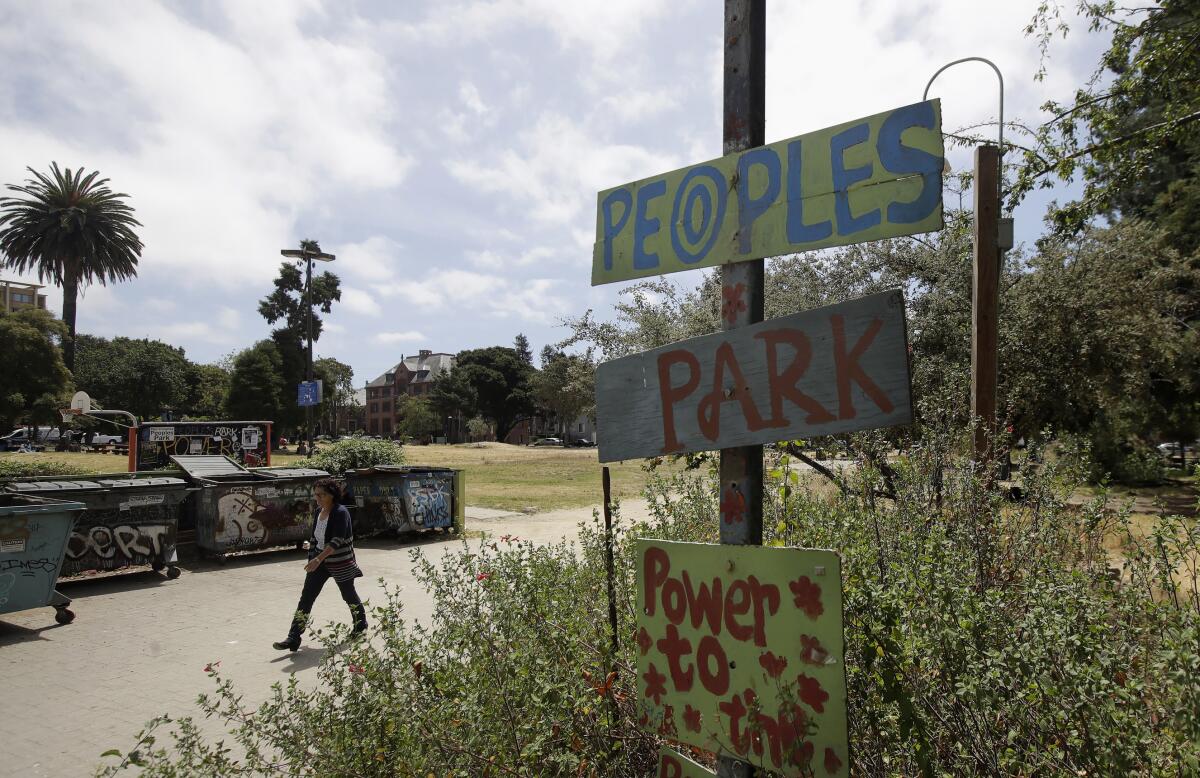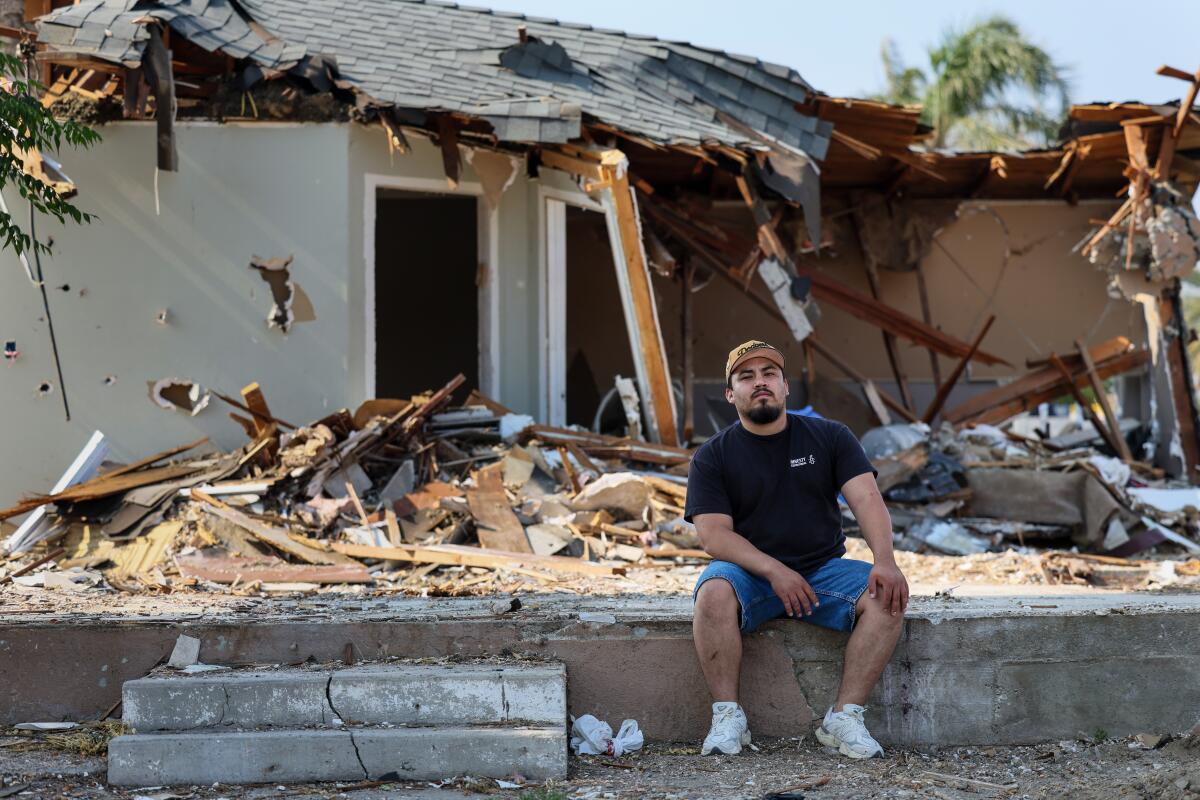UC Berkeley’s legal victory allows People’s Park housing project to proceed — for now

- Share via
Good morning. It’s Friday, June 7. Here’s what you need to know to start your day.
- Is the legal battle for Berkeley’s People’s Park finally over?
- What you need to know about Biden’s plan to end the war in Gaza.
- How to score a great campsite near L.A. without booking ahead.
- And here’s today’s e-newspaper
You're reading the Essential California newsletter
Our reporters guide you through our biggest news, features and recommendations every morning
You may occasionally receive promotional content from the Los Angeles Times.
UC Berkeley gets a legal victory in the battle for People’s Park
A decades-long land-use saga in Berkeley has (maybe) finally reached its conclusion.
The California Supreme Court ruled Thursday that UC Berkeley can build its long-planned student housing project on the community’s storied People’s Park. That decision overturned an appellate court ruling last year that sided with opponents who filed a lawsuit against the university to block the project.
“The housing components of the project are desperately needed by our students and unhoused people,” UC Berkeley officials said in a statement, adding that more than 60% of the site “will be revitalized as open park space.”
The ruling caps more than half a century of conflict over the ideal use of the land, my colleagues Jessica Garrison and Hannah Wiley reported Thursday, “that launched a 55-year experiment in utopian ideals — and the harsh realities that sometimes trail after them.”
A history of activism
The battles go back to 1969, when the university attempted to put up a fence around the space, which had become a site for local protests. That set off a violent conflict with armed officers and led then-Gov. Ronald Reagan to call in National Guard troops.
Tenacious activists eventually triumphed, declaring the 2.8-acre green space “People’s Park,” with the idea that it be a public haven free of government interference. Battles over the land continued as People’s Park remained a center for social activism for decades.
“For many it was a Berkeley institution, where generations of students and community members had picnics, smoked dope, organized to end apartheid and police brutality and communed naked with the moon, among other activities,” Hannah and Jessica reported. “But in recent years, it also became a refuge for homeless people and a magnet for drugs, rats and crime.”
A pivotal battle in the state’s housing wars
The conflict also highlights the walking-a-tightrope-while-juggling-chainsaws-esque challenge of trying to build housing in California.
In the case of People’s Park, some activists argued the land held more value as a public space with a rich history as a haven for free speech and organizing. Campus officials and local leaders contended it was most needed to house students — something the university and dozens more across the University of California and California State University systems have struggled to do amid the state’s broader housing crisis.
In an interview last year, UC Berkeley Chancellor Carol Christ said the university is able to house just 23% of its students. The project is seen as an important way to alleviate that crisis. It aims to provide high-rise dormitory housing for more than 1,000 students — plus supportive housing for more than 100 formerly unhoused people.
Then came a familiar extra chain saw to juggle: a CEQA lawsuit.

That refers to the California Environmental Quality Act, which requires public agencies to prepare detailed analyses of the potential environmental consequences of new construction — including housing, transit projects and freeway widening.
A “very-Berkeley coalition of park idealists and NIMBYs opposed to growth” sued the university, Jessica and Hannah wrote. They claimed officials failed to study more alternative sites and did not properly account for noise generated by “unruly parties.”
A state appellate court sided with the anti-development activists in a 2023 ruling.
That didn’t sit well with Gov. Gavin Newsom, who blasted the decision, saying the state “cannot afford to be held hostage by NIMBYs who weaponize CEQA to block student and affordable housing.”
It also didn’t sit well with state lawmakers, who passed Assembly Bill 1307 in direct response to the legal spat. The bill amended CEQA rules so that noise generated by people who live in a housing project can’t be viewed as a significant environmental impact.
Newsom signed the bill into law in September and Chief Justice Patricia Guerrero cited it in the court’s unanimous opinion this week, writing that “based on the new law, none of [the lawsuit’s] claims has merit.”
The court’s ruling is one thing. The response from fervent activists and local homeowners on the ground is another.
“There’s no way people are just gonna watch construction equipment go through these gates and not do something about it,” recent UC Berkeley graduate Enrique Marisol told The Times. “There’s no solid plan, but I’m certain there will be people in the streets.”
Today’s top stories

Crime and courts
- Three Jewish students sue UCLA, saying protesters blocked access to campus facilities.
- Rebecca Grossman is a narcissist who deserves life in prison for boys’ murders, prosecutors say.
- Feds charge 47 people linked to Sinaloa cartel drug trafficking network in Imperial Valley.
- ‘Like the Godfather’: A mafia informant’s brother has been killed years after dramatic testimony; an arrest was made.
- Before a Palmdale baby vanished, there were multiple abuse allegations. Why didn’t agencies intervene?
- An Orange County man has been convicted in the fatal stabbing of a man ‘over a truck and a set of lies.’
- Thousands of boxes of Lego toys have been recovered in bust of theft ring, police say.
Pat Sajak signs off
- Pat Sajak says goodbye on ‘Wheel of Fortune’: ‘It’s been an incredible privilege.’
- Pat Sajak’s final ‘Wheel of Fortune’ airs Friday. What to know about his spin as host.
More big stories
- LAUSD fined $8 million for staffing violations. Too many students, not enough teachers.
- Crime stats disappear from public view amid LAPD records system overhaul.
- California’s heat wave sets daily records, with possibly more on the way.
- Why California lawmakers are giving up a bid to repeal a nearly 75-year-old anti-public-housing measure.
- Leimert Park Juneteenth Festival has been canceled over costs and safety concerns.
- Vice President Kamala Harris was met by protesters outside a fundraiser in San Francisco.
- What you need to know about Biden’s plan to end the war in Gaza.
- Will Netflix get into the TV news business? Here are the pros and cons.
- Autism, dyslexia, ADHD. How the University of San Diego is helping ‘neurodivergent’ students succeed.
- A $6.8-million L.A. County program promised free food carts for vendors. It hasn’t delivered.
- California is ‘overdue’ for whooping cough outbreak as cases spike across U.S.
Get unlimited access to the Los Angeles Times. Subscribe here.
Commentary and opinions
- Mark Z. Barabak: Eleni Kounalakis wants to be California’s next governor. Her wealth shouldn’t decide the race.
- Mark Swed: What is the state of opera in L.A.? OperaFest LA tells only half the story.
- Michael Hiltzik: After smearing Anthony Fauci, House Republicans proceed to defame a prominent vaccine scientist.
- Sammy Roth: This ‘Fortnite’ island is the latest climate change battleground.
Today’s great reads
Inside the race to train more workers in the chip-making capital of the world. Taiwan produces nearly one-fifth of the world’s semiconductors, microchips that power just about everything — home appliances, cars, smartphones and more. But a pandemic-induced chip shortage, along with rising geopolitical tensions in Asia, have highlighted the fragility of the current supply chain — and its reliance on an island under the specter of a takeover by China.
Other great reads
- For Kelsey Grammer, ‘Frasier’ 2.0 is a fresh approach to a familiar character.
- Queer photographers’ most radical act? Turning the lens on themselves.
- In L.A., sometimes waiting in line is the whole event.
How can we make this newsletter more useful? Send comments to essentialcalifornia@latimes.com.
For your downtime
Going out
- 🏕️ How to score a great campsite near L.A. without booking ahead.
- 🎢 Knott’s Berry Farm encourages customers to snitch on line-jumpers, vows to kick cutters out.
- 🦟 Mosquitoes can ruin a hike. Here’s how to stop them.
- 🎤 Kendrick Lamar sets a victory-lap show for Juneteenth: Forum gig is first since Drake feud.
Staying in
- 📕 An entertaining new novel explores whether women working on OnlyFans are victims or savvy capitalists.
- 🦐 Here’s a recipe for buttery shrimp with dill.
- ✏️ Get our free daily crossword puzzle, sudoku, word search and arcade games.
And finally ... a powerful photo
Show us your favorite place in California! We’re running low on submissions. Send us photos that scream California and we may feature them in an edition of Essential California.

Today’s powerful photo is from Times photographer Robert Gauthier from Bloomington, Calif., where an e-commerce warehouse is taking out the neighborhood.
Have a great day, from the Essential California team
Ryan Fonseca, reporter
Defne Karabatur, fellow
Andrew Campa, Sunday reporter
Kevinisha Walker, multiplatform editor and Saturday reporter
Christian Orozco, assistant editor
Stephanie Chavez, deputy metro editor
Karim Doumar, head of newsletters
Check our top stories, topics and the latest articles on latimes.com.
Sign up for Essential California
The most important California stories and recommendations in your inbox every morning.
You may occasionally receive promotional content from the Los Angeles Times.






